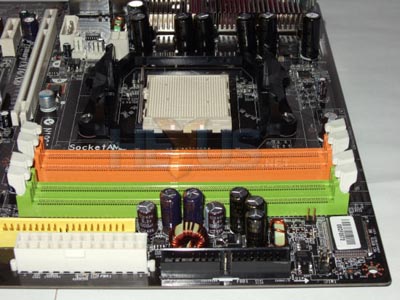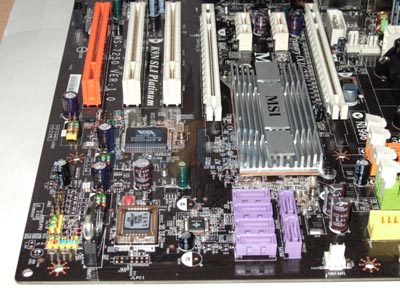Board Examination
We shall start with a nice bird's eye view of the board...
Despite the black PCB there seems to be plenty of colour on the board, from the USB and FireWire headers on the left, to the colour-coded memory banks. At first sight there are no revolutionary changes to board layout on the MSI K9N SLI Platinum. Let's take a closer look, shall we?
The CPU area is free of any interloping capacitors or other such components. Between the AM2 socket and the rear I/O panel is an array of VRMs, cooled by a passive heatsink. The heatsink, however, isn't particularly tall and doesn't provide an awful lot of cooling. Further, cooling relies greatly upon airflow in that area, which, depending on the CPU heatsink used, can be very poor. Indeed, a watercooled installation may well have minimal airflow in this region. During our testing we found this heatsink to get very hot, even with good airflow over it.
Moving towards the DIMM slots there are no nasty surprises, but towards the 24-pin ATX power connector we noted the sole Parallel ATA connector on the board is positioned directly above it. In many situations this can be quite an irritating place to have the connector, so we'd rather have seen it placed a bit further away.
At what is likely going to be the busiest part of the mainboard with respect to cabling, the arrangement is reasonably good. The six SATA ports operate at up to 3Gbps and are also ClickConnect-compatible to help prevent the SATA cables from slipping out. The chipset is, like the VRMs, passively cooled. Once again, good airflow is required to do a decent job of the keeping the 130nm-based chipset cool, and that heatsink's going to get hot regardless.
Install a long graphics card that takes up two slots into this motherboard and chances are you will lose the ability to use SATA port number 5, which is a little annoying. Still, there are five others, but what if you need six!? On the upside, there's a clear CMOS microswitch, rather than a jumper, making recovering from those BIOS fiddling-induced "oh crap" moments a little easier.
Here we have a close-up of the expansion slots, including the two 16-lane-wide PEG slots, which will run at x8 each in SLI mode. Remember, that the nForce 570 SLI chipset has a total of 28 PCIe lanes, as opposed to the '590 SLI's 46.
Even if you drop two double-slot cards into this system, you should still have a x1 PCIe slots and two PCI slots to populate with whatever expansion cards tickle your fancy (PPU, anyone?).
To the very left of the photo is the auxiliary molex for PCIe power; close to the PCIe slots, which makes sense, but is not the best place to route a power cable to.
Around the back there are the two gigabit ethernet ports with DualNet support, plus the usual array of connectors. It's interesting to see so many legacy connections, given that there's only one PATA connector on the board. It seems as if some legacy items just won't die.
There's 7.1 audio (actually, 8+2), which has analogue and digital connectivity. Digital connectivity comes in the form of either coaxial or TosLink, so there's a choice there depending on what your audio hardware might support. The sound chip used is the Realtek ALC883. Had the ALC883D version made its way onto the board, there'd have been Dolby Digital Live support. Alas, that isn't so.
The board comes across to us as pretty well-thought out. It's not perfect, but with the huge number of components required on a product like this, achieving perfection is rare.















